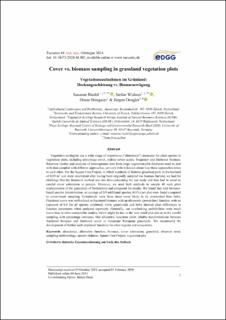Please use this identifier to cite or link to this item:
https://doi.org/10.21256/zhaw-31055Full metadata record
| DC Field | Value | Language |
|---|---|---|
| dc.contributor.author | Riedel, Susanne | - |
| dc.contributor.author | Widmer, Stefan | - |
| dc.contributor.author | Bringuier, Orane | - |
| dc.contributor.author | Dengler, Jürgen | - |
| dc.date.accessioned | 2024-07-12T08:34:02Z | - |
| dc.date.available | 2024-07-12T08:34:02Z | - |
| dc.date.issued | 2024-06-04 | - |
| dc.identifier.issn | 0373-7632 | de_CH |
| dc.identifier.issn | 0722-494X | de_CH |
| dc.identifier.uri | https://digitalcollection.zhaw.ch/handle/11475/31055 | - |
| dc.description.abstract | Vegetation ecologists use a wide range of importance (“abundance”) measures for plant species in vegetation plots, including percentage cover, ordinal cover scales, frequency and fractional biomass. Resurvey studies and analyses of heterogenous data from large vegetation-plot databases need to deal with data sampled with different approaches, yet very little is known about how these approaches relate to each other. For the Square Foot Project, in which hundreds of historic grassland plots in Switzerland of 0.09 m2 size were resurveyed after having been originally sampled via biomass harvest, we had the challenge that the historical method was too time-consuming for our study and thus had to resort to careful cover estimation in percent. However, we used both methods to sample 40 such plots representative of the grasslands of Switzerland and compared the results. We found that with biomassbased species determination, an average of 0.9 additional species (4.6%) per plot were found compared to cover-based sampling. Graminoids were three times more likely to be overlooked than forbs. Fractional cover was well related to fractional biomass with an allometric (power-law) function, with an exponent of 0.6 for all species combined, while graminoids and forbs showed clear differences in function parameters when analysed separately. Generally, our overlooking probabilities were much lower than in other comparable studies, which might be due to the very small plot size or to the careful sampling with percentage estimates. Our allometric functions allow reliable transformations between fractional biomass and fractional cover in temperate European grasslands. We recommend the development of further such empirical functions for other regions and ecosystems. | de_CH |
| dc.language.iso | en | de_CH |
| dc.publisher | Floristisch-Soziologische Arbeitsgemeinschaft | de_CH |
| dc.relation.ispartof | Tuexenia | de_CH |
| dc.rights | https://creativecommons.org/licenses/by/4.0/ | de_CH |
| dc.subject | Abundance | de_CH |
| dc.subject | Allometric function | de_CH |
| dc.subject | Biomass | de_CH |
| dc.subject | Cover estimation | de_CH |
| dc.subject | Grassland | de_CH |
| dc.subject | Observer error | de_CH |
| dc.subject | Sampling methodology | de_CH |
| dc.subject | Species richness | de_CH |
| dc.subject | Square Foot Project | de_CH |
| dc.subject | Vegetation plot | de_CH |
| dc.subject.ddc | 333.7: Landflächen, Naturerholungsgebiete | de_CH |
| dc.subject.ddc | 577: Ökologie | de_CH |
| dc.title | Cover vs. biomass sampling in grassland vegetation plots | de_CH |
| dc.title.alternative | Vegetationsaufnahmen im Grünland : Deckungsschätzung vs. Biomassewägung | de_CH |
| dc.type | Beitrag in wissenschaftlicher Zeitschrift | de_CH |
| dcterms.type | Text | de_CH |
| zhaw.departement | Life Sciences und Facility Management | de_CH |
| zhaw.organisationalunit | Institut für Umwelt und Natürliche Ressourcen (IUNR) | de_CH |
| dc.identifier.doi | 10.14471/2024.44.003 | de_CH |
| dc.identifier.doi | 10.21256/zhaw-31055 | - |
| zhaw.funding.eu | No | de_CH |
| zhaw.originated.zhaw | Yes | de_CH |
| zhaw.publication.status | publishedVersion | de_CH |
| zhaw.volume | 44 | de_CH |
| zhaw.publication.review | Peer review (Publikation) | de_CH |
| zhaw.funding.snf | 197641 | de_CH |
| zhaw.webfeed | Vegetationsökologie | de_CH |
| zhaw.funding.zhaw | Square Foot Project | de_CH |
| zhaw.author.additional | No | de_CH |
| zhaw.display.portrait | Yes | de_CH |
| Appears in collections: | Publikationen Life Sciences und Facility Management | |
Files in This Item:
| File | Description | Size | Format | |
|---|---|---|---|---|
| 2024_Riedel-etal_Cover-vs-biomass-sampling-grassland-vegetation-plots_Tuexenia.pdf | 743.4 kB | Adobe PDF |  View/Open |
Show simple item record
Riedel, S., Widmer, S., Bringuier, O., & Dengler, J. (2024). Cover vs. biomass sampling in grassland vegetation plots. Tuexenia, 44. https://doi.org/10.14471/2024.44.003
Riedel, S. et al. (2024) ‘Cover vs. biomass sampling in grassland vegetation plots’, Tuexenia, 44. Available at: https://doi.org/10.14471/2024.44.003.
S. Riedel, S. Widmer, O. Bringuier, and J. Dengler, “Cover vs. biomass sampling in grassland vegetation plots,” Tuexenia, vol. 44, Jun. 2024, doi: 10.14471/2024.44.003.
RIEDEL, Susanne, Stefan WIDMER, Orane BRINGUIER und Jürgen DENGLER, 2024. Cover vs. biomass sampling in grassland vegetation plots. Tuexenia. 4 Juni 2024. Bd. 44. DOI 10.14471/2024.44.003
Riedel, Susanne, Stefan Widmer, Orane Bringuier, and Jürgen Dengler. 2024. “Cover vs. Biomass Sampling in Grassland Vegetation Plots.” Tuexenia 44 (June). https://doi.org/10.14471/2024.44.003.
Riedel, Susanne, et al. “Cover vs. Biomass Sampling in Grassland Vegetation Plots.” Tuexenia, vol. 44, June 2024, https://doi.org/10.14471/2024.44.003.
Items in DSpace are protected by copyright, with all rights reserved, unless otherwise indicated.